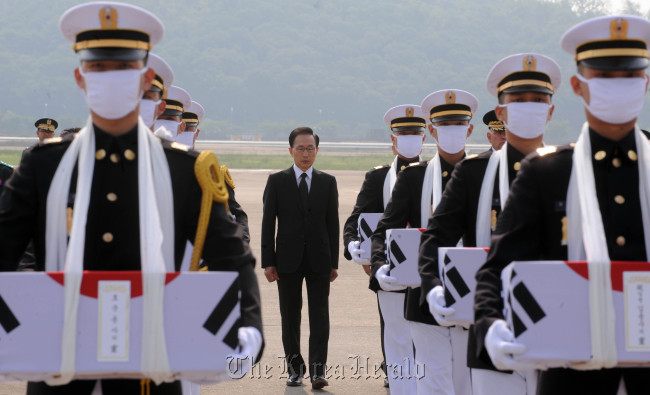The remains of 12 South Korean soldiers found north of the military demarcation line arrived in Seoul on Friday.
It is the first time for the remnants of South Korean soldiers killed in the Korean War to be returned from North Korea since the cease-fire in 1953.
“The Republic of Korea was defended as they fought at the risk of their lives. We have to find them, even their remains, who sacrificed their lives for the country, to the end. There are no greater patriots than them,” President Lee Myung-bak said to the families of the deceased soldiers ahead of the ceremony at the military airport in Seongnam, south of Seoul where the remains were flown in via Hawaii.
“There are many things to do if unification happens, but this will probably be the first thing we have to do. Finding the remains of those killed while defending the country is an important job we have to do.”
The remains were among the 226 bodies recovered in the northern part of North Korea by a U.S. excavation team between 2000 and 2004. The recovery efforts have since been halted over concerns for the safety of the U.S. personnel.
 |
President Lee Myung-bak walks behind the honor guard carrying the remains of the 12 South Korean soldiers that arrived in Korea at the military airport in Seongnam, Gyeonggi Province on Friday. (Chung Hee-cho/The Korea Herald) |
The remains were taken to the U.S., and subsequent DNA tests showed that they were Asian.
President Lee, wearing a black suit and accompanied by Minister of Defense Kim Kwan-jin and U.S. Army Gen. James Thurman, the commander of U.S. Forces Korea, waited with a solemn expression as the special Air Force transporter approached the runway around 8:40 a.m., carrying the remains of the deceased soldiers.
The coffins made with foxglove tree wood in the traditional Korean manner were received in a military ceremony. The president and the attending military personnel saluted as they were carried onto military vehicles to be carried to the National Cemetery.
Of the twelve sets of remains, two have been identified as Private First Class Kim Yong-soo and Lee Kap-soo who were Korean Augmentation Troops to the United States Army or KATUSA assigned to the U.S. 7th Infantry Division. According to the Ministry of Defense, 43,600 South Koreans were enlisted as KATUSA troops, of which 11,365 died or went missing in action.
Kim was killed during the Battle of Chosin Reservoir, known as the Battle of Jangjin Reservoir in Korea, while Lee was killed in action in Hagaru-ri, near the reservoir.
The Battle of Chosin Reservoir took place from Nov. 27, 1950 to Dec. 11, 1950. During the two-week long engagement, the U.S. 1st Marine Division and the 7th Infantry Division were surrounded by a much larger Chinese force, and the allies sustained heavy casualties.
Kim and Lee will be interred at the National Cemetery in Daejeon during June.
The Ministry of National Defense’s division for KIA Recovery and Identification plans to conduct further DNA tests and analyze records to identify the remaining sets of remains.
“The return is meaningful in that it was achieved through close cooperation between Korea and the U.S. Although the remains were retrieved by the U.S., this is the first step in bringing home the remains of other South Korean soldiers buried in North Korea,” the Defense Ministry said in a statement.
According to the ministry, the remains of between 30,000 and 40,000 South Korean soldiers are estimated to be buried within the demilitarized zone. The Defense Ministry added that the South Korean government is prepared to conduct joint excavation projects with the North, but such programs have been made difficult due to continuing military provocations from Pyongyang.
By Choi He-suk (
cheesuk@heraldcorp.com)







![[Today’s K-pop] Blackpink’s Jennie, Lisa invited to Coachella as solo acts](http://res.heraldm.com/phpwas/restmb_idxmake.php?idx=644&simg=/content/image/2024/11/21/20241121050099_0.jpg)
